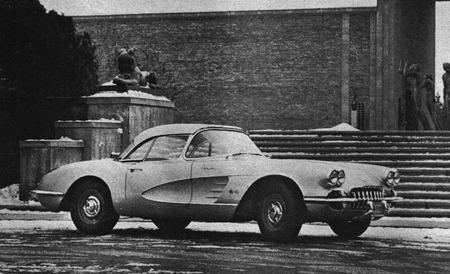Originally published in Sports Cars Illustrated in March 1959.
Racer Brown’s chart (see Part II of his article in next months’s issue) indicates that the all-out dual-quad version boasts better output than FI-cars at the top end. However, the ability of the latter to mix correct quantities of fuel and air, no matter what the car’s gyrations or speed, assures it of better lap times on any circuit.
That one Corvette is not the same as another is evident from the variety of options. What comes as a considerable surprise is the dualistic personality of the particular car tested. In the twinkling of a throttle linkage, it turns from a submissive, sidewalk stalker to a fierce, roaring eater-upper of metallic monsters. Just as quickly, it reverts to silent smoothness, its exhaust murmuring, barely audibly, “Who, me?”
This high output engine enjoys such tractability that it will pull smoothly from its 750 rpm warm idle in fourth gear. No flat spots, no hesitation, and no matter how fast you mash the throttle. Just to rub it in, you can start from rest in any gear whatsoever without stalling and with hardly a thought of the clutch lining. Strangely, starts in first gear seem equally touchy. Seems the “fast” clutch linkage (you have your choice of 4.5 or 6.4 inches of travel) has the unfortunate side characteristic that its mechanical advantage decreases quickly just as engagement occurs. For city traffic, we found that the combination of close ratios and the wide rev range made use of just first and fourth gears quite acceptable.
Despite this, the four speed gearbox ($188.30) was high on our list. For real get-up-and-go, it is well laid out. Shifting at 6500 rpm each time drops the revs only to 5000 or so, where the V8 is pulling strongly. To compare with the three speed box, all you do is skip second. Then coming out of first at 6500 drops revs to only 3900. Quite a difference when you’re trying to make tracks.
Acceleration, while breaking no SCI records, is tops for pushrod equipment, and at the top end, quite similar to the 3.0 liter Ferrari 250 GT tested last year. Not so good off the line though, proving that smoothness at low revs is not synonymous with strength.
Duntov, in his kidding, quizzical way, said, “You know, the 3.70 axle gives better acceleration times than the 4.11.” The operative word is “times”, and specifically the times for zero to sixty, eighty and one hundred.
Assuming one is driving the car for best acceleration down a quarter-mile, (which is what we’re after in our road test runs), this is quite true. With the 4:11 gears, shift points are 57, 75, and 95-1/2. But with the 3.70’s, they change to 63, 83, and 106. The elimination of one shift and the necessary, though slight pause more than makes up for the lessened torque multiplication.
We thought our car went pretty good, even if it does cost twice as much as the Chev “315” tested in our January issue. But a recent letter from Don Gist of Lake Worth, Florida shows what can be done. Similar to this test car but without the weighty non-essentials and using the 4.56 Positraction rear end plus the following modifications, he has recently recorded a standing quarter in 12.57 seconds, completing it at over 109 mph! The changes he mentions are Traction Masters (his is a ’58 model), open exhausts, an aluminum flywheel, Packard 440 wiring, 7.60 x 15 Bruce Slicks and the all-important flywheel shield. He adds, that the engine was “properly tuned.” Uh-huh.
If you want a particular kind of Corvette, pick out the options you want and GM’ll make it. If they haven’t the options you want, your local speed shop will.


Leave a Reply